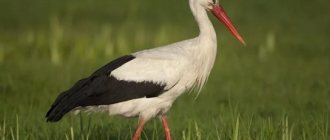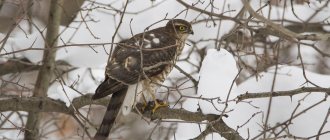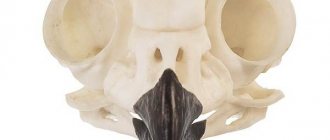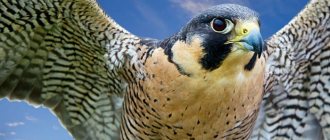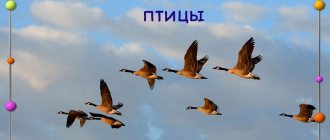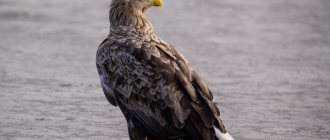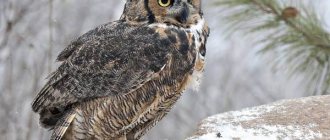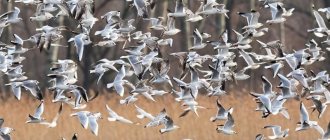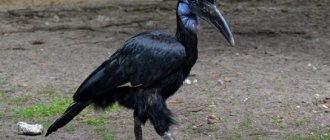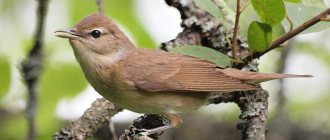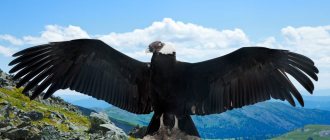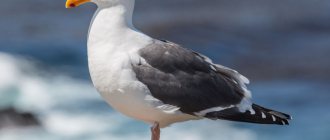Cities and semi-wild places in the Moscow region are important or even main habitats for some bird species. In this unusual environment, which is a combination of human genius and the forces of nature, a unique habitat has been created for bird species rarely found in other regions of the country.
Avifauna moves closer to human settlements by the arrival of the cold season of the year. Migrant species are found in parks; they are “city dwellers” in winter and return to nature when it gets warmer. These species do not need to fly to the warm South, because in cities it is not as cold as in the forest. Finches, goldfinches, wagtails, and cuckoos visit cities like village relatives visit people.
White stork
Large marsh bird. The plumage is white, the tips of the wings are black, the beak and legs are orange-red. The average weight of individuals is 3–4 kg. Inhabits swamps, canals, meadows and river banks.
It feeds on snakes, frogs, and fish. Does not disdain lizards. May eat small mammals or small birds. The white stork migrates from Europe to Africa for the winter.
Black stork
Similar in characteristics to the white stork. The exception is the color of the bird - it is almost all black (back, head, chest and tail). The ventral part is white. Average weight is about 3 kg. The bird lives throughout Eurasia. More often found in swamps and rivers. Arrives in Europe in mid-spring (late March - early April).
It feeds on fish, mice, insects, and mollusks. Can catch snakes and lizards.
The bird is rare. Listed in the Red Book of the Russian Federation and the CIS.
Deaf cuckoo
The bird has the standard coloration of the common cuckoo. The plumage of the male is light gray (ashy) in color. The female is brighter. She has visible red spots.
The deaf cuckoo lives in deciduous and coniferous forests and forest-tundra zones. Migration takes place in the fall in an easterly direction. Winters in the Philippines.
The bird's diet includes caterpillars, insects, and beetles. Eats butterflies, flies, spiders and chafers. In times of hunger, it can attack the offspring of other birds living nearby.
Common lentils
A small bird, similar in size to a sparrow. The head of the lentil is red, the plumage is gray-brown, and the belly is white. It breeds in Eurasia, and in winter flies to the southern part of East Asia.
Lives in densely growing forests and bushes. Can be found at the edge of a forest or near a river. It is difficult to see the bird - it is well camouflaged. The lentils give out a ringing whistle.
It feeds mainly on plant foods - berries, seeds. Rarely eats insects. Flies to wintering grounds in mid-August (from Europe to the east). Arrives in May.
Nightingale
Songbird. The nightingale is difficult to spot in the foliage. The feathered one is distinguished by its beautiful, melodic singing. The male and female have almost the same color: the abdomen is gray-white, the upper body and head are smoky brown, sandy.
Nightingales live in forest areas, in bushes, and in city parks. They feed on beetles and worms. They love spiders, caterpillars and ants. Collect seeds and berries.
Common cuckoo
A medium-sized bird (up to 600–700 g). The color is brown interspersed with dark and light shades. The cuckoo is famous for its lack of “maternal instinct.” She lays her eggs on other birds (she does not hatch them herself).
Lives in forests and swamps. It feeds on lizards, caterpillars, and beetles. Might eat a mouse.
The bird doesn't sing. She makes the familiar “ku-ku” sounds to everyone. The habitat covers many zones - from deserts to the Atlantic. Migratory bird. Winters in Africa.
Great cormorant
Large fishing bird. It has a long neck and a curved beak. The plumage color is black, the beak is white. The lower part of the body has a lighter shade. Cheeks yellow. Weight from 2 to 3 kg.
The cormorant lives in Europe, Africa, and North America. Lives on the shores of seas and inland waters. Migratory bird. Winters in the south of Crimea.
It feeds on fish (dives 4 m for it), insects and mollusks.
Zhelna
Another name is black woodpecker. Lives in the forests. It has a black color, the head (crest) is red. It feeds on insects (obtains them from tree bark). The voice is loud and melodic (reminiscent of the sound “kru-kru-kru”).
Habitat: forest-steppe of Eurasia. Loves coniferous and mixed forests, deep taiga. In search of food, the bird hollows out trees, getting beetles and larvae.
Hoopoe
Migratory, nesting bird. The representative has a bright color: the head is red, the body with wings is striped (black-brown-white). The breast and lower part have a pinkish tint.
Lives in the Leningrad and Moscow regions, in the taiga zone. Prefers open places with sparse shrubs and grass. Not afraid of people.
It feeds on ants, beetles, and caterpillars. The bird's voice sounds like "whoop-whoop-whoop." The hoopoe also hisses and squeals.
Magpie
The bird looks like a crow. The predominant color is black and white. The tips of the wings are greenish-purple, the belly is white. The tail is long. Lives in all parts of Russia. Settles in forests and parks. Makes chirping sounds.
The bird has high intelligence. She is trainable and can recognize herself in the mirror.
It feeds on forty lizards, beetles, and mice. Does not disdain carrion. Can destroy nests.
Tufted duck
Belongs to the duck family. The bird is small - weighing up to 750 g. Color - black (the male may also have white sides). The beak is short and wide. The sounds of a duck are “gyun-gyun.” It lives in bodies of fresh water: lakes, ponds, rivers.
Arrives in April, as soon as the ice melts. Spends almost all his time in the water. Dives up to 4 m deep. The blackling feeds on small fish, crustaceans, and mollusks. Sometimes eats aquatic plants.
The bird is listed in the Moscow Red Book.
Saker Falcon
Large falcon bird. Colour: The back is brown against a background of contrasting gray feathers. Habitat: plateaus, steppes of southern Siberia and the Baikal region.
The bird hunts small mammals (mice, gophers). Belongs to partially migratory birds. It is considered an endangered species - the balaban is listed in the Red Book.
Waxwing
Refers to songbirds. Outwardly it resembles a sparrow with a crest. Color: gray-pink. There is a yellow stripe along the edge of the tail. Breeds in the taiga forests of Russia, migrates to the southern parts of the continents.
The waxwing is a flocking bird. It feeds on berries, larvae, and insects. Makes trills “svi-ri-ri-ri”.
Snipe
A small dark brown bird with a long stick-shaped beak. The snipe lives in fresh or salty water areas with dense vegetation. Loves marshy areas and wet meadows.
Winters in Southern Europe, migrates to Asia. Birds eat spiders, worms, small crustaceans, seeds and plant fibers.
Golden eagle
Large bird of prey. Refers to hawks and eagles. The difference from its relatives is its “golden” head. The bird has large eyes and a hooked beak. Wingspan up to 2 meters. Weight - up to 5 kg.
Golden eagles live in open areas - on plains and foothills. The bird migrates short distances. It feeds on rabbits, mice, hares. Can grab a fox and a crane. Attacks young mammals - deer, sheep.
Northern chatter
Reed migratory bird. Appearance similar to a sparrow. The main color is gray-brown, the tummy is whitish. Habitats: dense bushes, forest edges, clearings and thickets.
The bird is listed in the Red Book of the Yaroslavl region and R. Mordovia. A little-studied species.
Burgomaster
Large polar gull (weight up to 2 kg). The color is pale: the head and chest are white, the back to the tail is grayish. The bird lives on rocky coasts and islands. The glaucous glaucous is an omnivorous bird. Loves shellfish, berries, other people's eggs and chicks. Does not refuse carrion.
Leads a semi-nomadic lifestyle. Winters near the nest.
Woodcock
Nocturnal migratory bird. Lives in swampy areas. Loves old, damp forests and wastelands. Woodcock is a solitary bird (it rarely forms groups). Is the object of hunting.
Woodcock is the size of a pigeon. It has a straight beak and a mottled brown-orange color.
It feeds on larvae, beetles, spiders, and worms. Rarely eats plant foods (corn and oats).
Bluethroat
Gray passerine bird. Males have a brightly colored breast. Females are gray-brown in color with a dotted necklace on the chest.
The voice is like a nightingale. The bluethroat can interestingly copy the sounds of many birds.
It lives near rivers (with abundant, dense vegetation and bushes along the banks), in meadows and near swamps. It is a migratory bird, but does not form a flock.
Great godwit
A large sandpiper with a small head and a long, needle-like beak. The bird's head and neck are brown, its belly is white, and the rest of the body is a dirty brown-gray hue.
Loves damp lowlands, swamps - places with high humidity. The bird is listed in the International Red Book, but is hunted in Russia.
It feeds on insects, frogs and worms. Loves crustaceans.
Godwit
A copy of the Great Godwit, only with a small neck and short beak. Migratory bird. The distribution area, habitats and nutrition are similar to its larger brother described above. The security status is not of concern.
Wryneck
A small bird from the woodpecker family. It is migratory and spends the winter in Africa. It is called the whirlwind because of its unusual behavior - when it is picked up, it fluffs up and rotates its neck.
The color is cuckoo with brown-white-black splashes. On the head there is a crest of the same color. The abdomen is gray-white.
Loves deciduous and mixed forests - lives in old trees. Feeds on insects.
Nuthatch
An active and noisy bird (makes whistles, gurgles and other sounds) from the passerine family. There are many species of nuthatch. It is the species that determines the color of the bird. The predominant colors are blue-gray back and gray belly.
The bird feeds on plant and animal food (beetles, butterflies, larvae, nuts, seeds). Loves to live next to a person. Easily gets used to hands.
House sparrow
A classic sparrow, which is distributed throughout Russia (especially in urban areas). The main color of the feather cover is brown, the belly is gray, the back and head are brown-black.
The bird has settled down well next to humans. It feeds on vegetation and insects.
field sparrow
The bird is similar to a house sparrow, but lives further from humans - on the outskirts of the city, near plantings and vineyards. Loves bushes and thickets.
Slightly smaller in size than the brownie, the color is more saturated.
The tree sparrow is a flocking bird. Leads a sedentary lifestyle. It feeds on seeds and insects.
Great tit
It is also a well-known bird that lives in many Russian cities. It has a yellow belly and a black tie. The bird's cheeks are white. It is similar in size to a sparrow.
In the summer it lives in the forests, but with the onset of winter it flies to the city (to feed).
In summer, tits eat caterpillars, beetles, butterflies, and spiders. They love plants and berries.
Long-tailed tit
This representative is very different from the ordinary tit. The bird's tail is long. Color: head - white, back - gray-pink, belly - white-gray-pink. Has abundant downy cover.
The tit lives in the forest, near rivers and in park areas. Loves bushes. It feeds on insects and plant fruits.
Crow
The general name of a variety of species category. There are many types of crow - black, big-billed, gray, etc. Each of them has its own coloring and behavior.
Crows spend the night in a group, gathered in a large group. They also obtain food.
They are easily tamed by humans and can be trained.
Gray Crow
Large, black and gray bird. Considered a singer. She is distinguished by reasonable behavior - she is very sociable, protects her family, and forms packs.
It feeds on animal food (beetles, caterpillars, mice). May eat carrion. In the city limits he finds food in garbage dumps.
Great bittern
The largest specimen in its family (up to 2 kg). Cuckoo-colored plumage. Thick, elongated neck. Lives in reed thickets and places with standing water. Loves mild climates. Single.
The bittern feeds on eels, fish and invertebrates. Screams loudly “trum-u-trum” at night and in the morning.
Wood Pigeon
A bird from the pigeon family, widespread throughout Russia. Cautious. The color is blue or grayish. Makes cooing sounds “kru-ku-kru-kru”. Loves nature, villages.
Feeds on seeds. Rarely eats insects. It is an object of sport hunting. Because of this, its numbers are gradually declining, but the bird is not under protection.
Blue tit
A small bird that looks a bit like a tit. It has yellow belly plumage, white cheeks, and gray back. Loves to live in gardens and parks. Finds food in feeders. He easily lets people approach him.
In the wild, it lives on the edges of the forest and feeds on worms, beetles, and berries.
Red-throated loon
It is the smallest of its kind. The main color is brown, the head is gray, the belly is white-gray. There is a red-orange spot on the neck.
Loves fresh ponds, swamps and overgrown lakes. He cannot stand the presence of people and leaves his home at lightning speed.
The loon feeds on small and medium-sized fish, frogs and insects.
Starling family
The gray starling with a long beak is distinguished by plumage of a color consistent with its name. The head and abdomen are white, and the base of the beak is yellow. Young representatives of the species are often found with an orange breast. The starling is a migratory individual that prefers to settle in mixed forests and lives in flocks. The gray bird prefers various larvae and insects on its menu.
The pink starling is another representative of the birds of the Moscow region. Juveniles of this species have lighter plumage than mature ones. The adult has a crest on its head. The pink-breasted migratory bird organizes its nests in rock voids, cliffs and woodpiles. Eggs are laid in late spring or early summer; the clutch consists of 4-6 white eggs. The bird actively exterminates locusts and other pests. The crested bird eats up to 200 large insects per day.
The most common species of bird that catches your eye is the house sparrow. The male has a gray head, black chest and throat, white stripes on the shoulders, and a brown stripe running from the beak to the eyes. Females and younger individuals have brownish plumage, gradually becoming lighter towards the lower part of the body. On the back there is a feather with dark and light splashes.
The most common species of bird that catches your eye is the house sparrow
Interesting facts about redstarts
- Representatives of this species sing almost around the clock, being especially active early in the morning and late in the evening;
- A characteristic feature of the bird’s behavior is the constant shaking of its tail, because of this the red plumage shimmers in the sun like a fire;
- The redstart is also called the coot, the kaluferka, and the redstart;
- When kept in captivity, the birds' wings are tied up for the first time, as they often injure themselves. With proper care they live 5-6 years.
- In 2015, the redstart was declared bird of the year in Russia
Kinds
The common redstart is more often than other relatives found in the description of species from the passerine order of the flycatcher family. In total, redstarts include 13 species inhabiting India, China, and many Asian countries. The main differences between birds are in the original color of their plumage. All are united by a fragile physique and an awl-shaped beak.
Common redstart
The habitat of redstarts is typical for Russia:
- gray-headed (common);
- black redstarts;
- garden;
- Siberian;
- red-bellied;
- coot redstarts.
Grey-headed (common) redstart. Luxurious plumage, orange and black, is characteristic of males. The white forehead gives the species its name. The beautiful bird cannot be confused with anyone; it is characterized by a sonorous singing. The redstart bird lives in northwestern Africa and a large part of Eurasia.
Grey-headed Redstart
Black redstart. A small bird, smaller than a sparrow, the individual’s weight is only 14-18 grams. The male has black plumage on the forehead, cheeks, and neck, the upper part of the body is gray, and the tail is orange with black speckles.
The female redstart is more uniform in color; the undertail and uppertail, like the male, are red in color. Birds live in the mountain landscapes of Asia and Europe. They love rocky niches, cliffs, and slopes strewn with pebbles.
Redstart nigella
In cities, birds are attracted to industrial areas with factory chimneys and scaffolding. Black Redstarts have been spotted gathering in groups on church domes. The singing of blacklings is rough, hoarse, with multiple repetitions.
Garden redstart. A bright bird, the top of which is ashen, the forehead, throat, wings are partially black, and the belly is white. Bright red plumage adorns the chest, sides, and tail. There is a white spot on the forehead. Females are more modest in color, although rusty-red edges also decorate their gray outfit.
Female garden redstart
Favorite habitats are in the trees of old parks and orchards. The redstart bird lives in coniferous, mixed forests with bushes. The songs of the garden dweller are euphonious and sonorous. Ornithologists note a tendency to imitate other people's trills, for which they call it a mockingbird.
Siberian redstart. The color resembles an ordinary (gray-headed) representative of the species, but the white spot is not on the head, but on the wings. The name of the bird reflects its habitat. It is found in the south of Siberia, in the Amur region. It builds nests under the roofs of houses, in the hollows of old trees, and in the cracks of rocky cliffs.
Siberian redstart
Red-bellied redstart. Among its relatives, the bird is larger in size. The color resembles the Siberian species, but the plumage is brighter. A male redstart with a reddish rufous breast and white spots on the sides of the wings. The female has no light spots. In Russia it is found in the mountains of the Central Caucasus and Southern Siberia. Favorite habitats are in thickets of sea buckthorn and river willow.
Red-bellied Redstart
Redstart coot. A small bird, very active and melodious. Bright color, slender build and lively disposition attract attention to the inhabitants of parks, gardens, and wilderness areas.
Redstart coot
The constant shaking of the red tail, high legs, and frequent flights are characteristic of the coot. The bird got its name from the white spot on its forehead. The singing of the redstart is sonorous, beautiful, with elements of imitation at the end. The early songs of the coot at dawn are sometimes confused with the trills of nightingales.
Listen to the voice of the redstart coot
